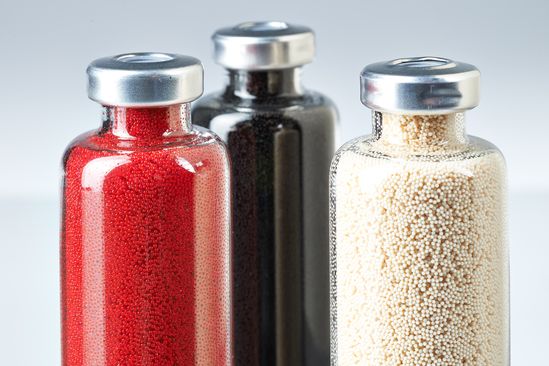Asia
EMEA

LANXESS Canada Contacts
Contact our Sites in Canada
Media Inquiries
General Inquiries
Please click here to e-mail LANXESS Canada with product inquiries and general requests.
Global Press Releases
2014-10-27
LANXESS at the 2014 VGB Conference
Ion exchange resins and membrane elements for “Chemistry in Power Plants”
New high-performance resins for condensate polishing
Specialty chemicals company LANXESS will be presenting its products and services from October 29 to 30, 2014, at the 50th VGB (European technical association for power and heat generation) Conference, “Chemistry in Power Plants”, in Linz, Austria. As a full supplier of water treatment solutions, the company also will be appearing at the accompanying exhibition, showing its successful Lewatit-brand ion exchange resins, including new products for condensate polishing, such as Lewatit MonoPlus S 150 CP and Lewatit MonoPlus S 215 KR.
In addition to ion exchange for processing boiler feed water, membrane technology also is used in power plant applications, for example in the form of reverse osmosis. LANXESS offers its Lewabrane line of membrane elements for this segment, which boast a long service life and low energy requirement.
At the conference accompanying the exhibition, Dr. Jens Lipnizki, Technical Marketing manager in the LANXESS Liquid Purification Technologies (LPT) business unit, will be presenting a paper on October 29, 2014, on “Characterizing a reverse osmosis membrane and the influence of polymer chemistry on the process”. He will explain how users can select the right product from all the different membrane types available on the market in terms of the desired surface charge, the diffusion behavior and, in particular, the salt rejection. His presentation further explains the chemistry of the polyamide layer, analysis of the membrane and the influence of polymerization on the rejection of salt mixtures, boric acid, silicates and organic substances. His overall goal is to promote a deeper understanding of the chemistry of reverse osmosis membranes and their separation mechanisms.
Ion exchange resins for use in the energy and nuclear industries
Ion exchange resins from LANXESS help to ensure the efficient, safe and reliable operation of power plants. They are used to demineralize the cooling and make-up water, and to polish the condensate in the water-steam circuits that are the heart of all thermal power plants. The high regenerability of the resins, combined with their chemical and mechanical stability, supports long dwell times, which in turn guarantees economical power plant operation.
Lewatit MonoPlus S 150 CP is a strongly acidic, gel-type, cation exchange resin with a uniform particle size distribution (uniformity coefficient < 1.1) and high regeneration efficiency. Hans-Jürgen Wedemeyer, Technical Marketing manager in the LANXESS LPT Business Unit, says: “The new, monodisperse Lewatit MonoPlus S 150 CP is particularly suitable for polishing alkalized condensate circuits in fossil fuel-fired power plants, because it displays very high performance, with a total capacity of 2.0 equivalents per liter in the H form. The product further displays optimized leaching behavior.” This property is an important quality characteristic for the effectiveness and cost-efficiency of an ion exchange resin. The weaker a tendency of a resin grade toward “self-leaching,” the less total organic carbon (TOC) is released. The release of organic substances is undesirable, because it can lead to carbon dioxide formation in the power plant and deterioration of operating conditions in the condensate circuit.
The new grade Lewatit MonoPlus S 215 KR is a strongly crosslinked, highly acidic, gel-type cation exchange resin with a monodisperse particle size distribution. The total capacity is in the region of at least 2.4 eq/l (equivalents per liter) in the H form. In specially purified and highly regenerated form (minimum 99% H+), it fulfills the special requirements of the nuclear industry. In addition, the high crosslinking results in unusually low TOC release. “In the nuclear industry, ion exchange resins sometimes are not regenerated, meaning that a high loading capacity for radioactive cations, like that of Lewatit MonoPlus S 215 KR, is a major advantage,” explains Wedemeyer.
The nuclear resins in the Lewatit KR line stand for very high mechanical, chemical and osmotic stability. Their unique monodispersity at a very low percentage of fine particles results in very low pressure losses compared to heterodisperse, standard ion exchange resins. Used in radioactive water circuits, they carry out a number of tasks and produce a water quality that fulfills all requirements of the nuclear power industry. On account of their outstanding hydraulic properties, these ion exchange resins enable very high flow rates.
In nuclear power plants, ion exchange resins also are important components in the chemical and volume control system (CVCS), which controls and monitors water volumes and dissolved constituents in the cooling circuits. Selective ion exchange resins can remove radioactive and non-radioactive ions from the process water and wastewater streams. The water in the holding basins for spent fuel elements also is passed through ion exchange resins for treatment.
For these and other applications, LANXESS offers a comprehensive range of special ion exchange resins that are tailored to specific requirements. Detailed information can be found on the new Internet site at http://lpt.lanxess.com.
LANXESS is a leading specialty chemicals company with sales of EUR 8.3 billion in 2013 and about 16,900 employees in 31 countries. The company is currently represented at 52 production sites worldwide. The core business of LANXESS is the development, manufacturing and marketing of plastics, rubber, intermediates and specialty chemicals. LANXESS is a member of the leading sustainability indices Dow Jones Sustainability Index (DJSI World and DJSI Europe) and FTSE4Good as well as CDP’s Climate Disclosure Leadership Index (CDLI).
- Gallery




